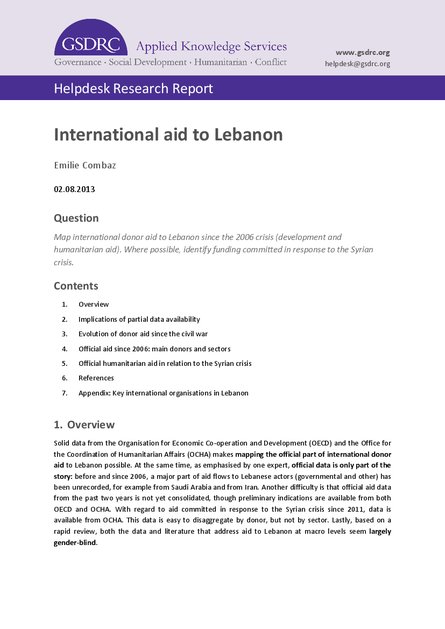
Solid data from the Organisation for Economic Co-operation and Development (OECD) and the Office for the Coordination of Humanitarian Affairs (OCHA) makes mapping the official part of international donor aid to Lebanon possible. At the same time, as emphasised by one expert, official data is only part of the story: before and since 2006, a major part of aid flows to Lebanese actors (governmental and other) has been unrecorded, for example from Saudi Arabia and from Iran. Another difficulty is that official aid data from the past two years is not yet consolidated, though preliminary indications are available from both OECD and OCHA. With regard to aid committed in response to the Syrian crisis since 2011, data is available from OCHA. This data is easy to disaggregate by donor, but not by sector. Lastly, based on a rapid review, both the data and literature that address aid to Lebanon at macro levels seem largely gender-blind.
Lebanon has received large volumes of international aid since the 1970s, in both the development and humanitarian fields. Due to alternating phases of large-scale violence and lesser confrontations, the emphasis in aid has regularly gone back and forth between, or at times combined, types of aid: humanitarian assistance (emergency and recovery), reconstruction, or more traditional development.
Since the civil war (1975-1990), core players in international aid have mostly remained the same. Major bilateral donors have been Western states (especially the USA and some European countries), Western-allied Gulf countries such as Saudi Arabia or Kuwait, and Iran. International organisations from the UN system, from the humanitarian, refugee and development fields, have been consistently strong aid contributors. Likewise, non-governmental organisations (NGOs) from all three fields, along with actors from the Red Cross Red Crescent system, have long been active in Lebanon, as contributors or channels for aid. Mac Ginty and Hamieh (2010, p. 39) also emphasise that Lebanese actors themselves have generally played a major role in humanitarian, reconstruction and development aid, as implementers and donors. An appendix to this report provides a selection of key organisations active in official aid to Lebanon (multilateral and bilateral donors, as well as NGOs and similar organisations).